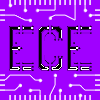The table below presents the notation for terminal voltages and currents:
CURRENT RELATIONSHIPS
The two pn junctions of the BJT can be independently biased, to result in four possible transistor
operating modes as summarized in Table 3-3. A junction is forward-biased if the n material is at a lower
potential than the p material, and reverse-biased if the n material is at a higher potential than the p
material.
Saturation- With both junctions forward-biased, a BJT is in saturation mode and facilitates high current conduction from the emitter to the collector. This mode corresponds to a logical "on", or a closed switch. (Base higher than emitter, but collector is not higher than base.)
Cut-off- In cutoff, biasing conditions opposite of saturation (both junctions reverse biased) are present. There is very little current flow, which corresponds to a logical "off", or an open switch. (Base lower than emitter, but collector is higher than base. It means the transistor is not letting conventional current to go through collector to emitter.)
Inverse- The inverse mode is a little-used, inefficient active mode with the emitter and collector interchanged. (Base lower than emitter, collector lower than base: reverse conventional current goes through transistor.)
Linear/Active- describes transistor operation in the region to the right of saturation and above cutoff (Base higher than Emitter, Collector higher than Base)
Sources:










3 people rectified:
hmm, this is funny. we just finished this lesson a couple of weeks ago. haha.
really? you're an ECE student too? :)
nope. EE student. haha.
Post a Comment